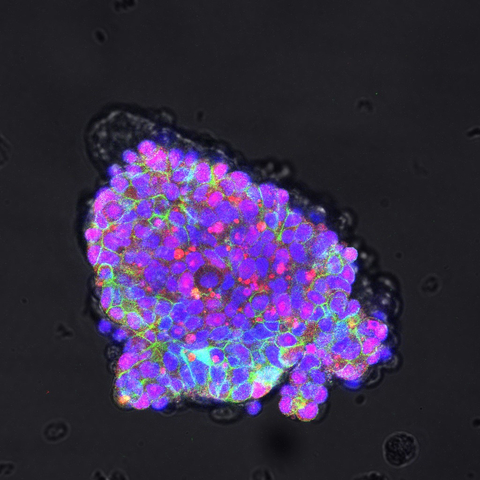Successes across the de-extinction pipeline signal that the thylacine project is on track as Colossal continues its global effort to fight the extinction crisis.
DALLAS & MELBOURNE, Australia--BUSINESS WIRE--
Today Colossal, the de-extinction and species preservation company, announces numerous breakthrough successes in all stages of the thylacine de-extinction effort that put the company much closer to returning the iconic thylacine to Australia. From the generation of the highest quality ancient genome to date, to breaking records in multiplex genome editing, to innovations in assisted reproductive technologies for marsupials, Colossal’s success in developing de-extinction technologies will not just support the important thylacine effort but will also help combat the world’s extinction crisis.
This press release features multimedia. View the full release here: https://www.businesswire.com/news/home/20241016627971/en/

Colony of induced pluripotent stem cells (iPSCs) made from the skin cells of the fat tailed dunnart (Graphic: Business Wire)
Thylacines, which have been extinct since 1936 due to human depredation, are a keystone species that is vital to the healthy function of the Tasmanian ecosystem but are also an ideal candidate for the Colossal mission. Given their relatively recent extinction, many thylacine specimens are exceptionally well preserved, allowing Colossal and its collaborators to push the boundaries of ancient DNA science and create the genomic blueprints for the thylacine’s return. In 2022, Colossal Biosciences with local stakeholders announced the thylacine de-extinction project with the goal of returning the thylacine to native Tasmania to staunch biodiversity loss and preserve the local ecosystem.
“Our teams are making incredible scientific leaps while on track to de-extinct the thylacine,” said co-founder and CEO of Colossal Ben Lamm. “We are proud to have our work so well received by the Australian and Tasmanian communities and for these communities to be our partners on this journey. We are pushing as fast as possible to create the science necessary to make extinction a thing of the past. These advancements in this project are a huge step forward in that mission.”
The World’s Most Complete Ancient Genome
Capitalizing on one of the best preserved specimens known for any extinct species, the thylacine team produced a newly reconstructed thylacine genome that is the most complete and contiguous ancient genome of any species to date. This advancement is record-breaking and will accelerate the team’s work in returning the thylacine to Australia.
The new thylacine genome is exceptional both in its contiguity – it is assembled to the level of chromosomes – and its accuracy – the genome is estimated to be >99.9% accurate, and even includes hard-to-assemble repetitive features such as centromeres and telomeres, which are challenging to reconstruct even for living species. The genome has only 45 gaps, which will be closed by additional sequencing efforts in the coming months. This genome is a first for an extinct species, and a feat that many scientists believed would never be achieved for extinct species. The team is continuing to compare this high quality genome to genomes from close relatives of the thylacine to identify thylacine-specific evolutionary changes.
“The thylacine samples used for our new reference genome are among the best preserved ancient specimens my team has worked with,” said Beth Shapiro, Colossal’s Chief Science Officer and the Director of the UCSC Paleogenomics Lab, where the samples were processed. “It’s rare to have a sample that allows you to push the envelope in ancient DNA methods to such an extent. We’ve delivered a record-breaking ancient genome that will accelerate our thylacine de-extinction project.”
The exceptional quality of the new thylacine genome, which is around 3 billion bases in length, is due to the unusual preservation of long DNA sequences. Most ancient specimens retain only short DNA sequences with little to no RNA, due to degradation that happens after the organism dies.
The team was also able to isolate long RNA molecules from preserved soft tissues from a 110-year-old thylacine. RNA is a much less stable biomolecule compared to DNA and therefore its preservation is extremely rare in historic specimens. The sample is a complete head of an adult thylacine that was skinned and preserved in ethanol - a preservation method that probably led to the exceptional preservation of RNA. Impressively, the team was able to recover RNA fragments that were up to 2,000 bases in length.
Unlike the DNA, which is the same in almost every nucleus in every cell in our body, the RNA that is expressed varies within each tissue, and contains a complete readout of all the active genes required for the functioning of a particular tissue. The preservation of a complete head means that RNA could be sampled from several important tissues, including the tongue, nasal cavity, brain, and eye.
“This exceptional sample provides a fantastic opportunity for us to understand gene expression in thylacines,” said Dr. Andrew Pask, a member of Colossal’s Scientific Advisory Board and the head of the Thylacine Integrated Genomic Restoration Research Laboratory at the School of BioSciences in the University of Melbourne. “With this new resource in hand we will be able to determine what a thylacine could taste, what it could smell, what kind of vision it had and even how its brain functioned!”
Together with the exceptional thylacine genome built from DNA, this new layer of RNA will lead to the first complete, new annotated extinct animal genome ever produced.
Breaking Records in Genetic Engineering: 300+ Unique Edits in a Single Cell
Thylacines were known for their distinctive jaw and skull morphology, similar to that seen in some canids - the family that includes wolves and dogs. This core thylacine trait has been one of the key targets this year for the thylacine team. To determine what genes underlie the thylacine craniofacial shape, the thylacine team compared genomes from thylacines with genomes from wolves and dogs with similar craniofacial shapes, and identified regions of the genomes that are evolving at an accelerated pace in both groups. These regions of the genome, which the team is calling “Thylacine Wolf Accelerated Regions” or TWARs, are predicted to drive morphological similarities between thylacine and wolf.
The team set out to prove that the TWARs drive the evolution of skull shape in mammals. First, they used high throughput reporter assays in bone cell lines to examine the functions of each TWAR. This identified TWARs that were active in bone tissues of a developing thylacine. Next, they determined when and where the TWARs activated gene expression by linking them to reporter genes and making transgenic mice with individual TWAR elements. Finally, they tested explicitly whether TWARs could change developmental outcomes by separately replacing three regions of the mouse genome with TWARs from the extinct thylacine – this ”knock-in” experiment replaced a component of mouse regulatory DNA with thylacine DNA. Each of these three DNA swaps impacted the development of the mouse skull in the predicted way, confirming that the identified TWARs drive changes in head shape.
“We’re beyond pleased to learn that these regions of the genome are impacting the craniofacial phenotype as we predicted,” said Sara Ord, Director of Species Restoration at Colossal Biosciences. “This is crucial evidence of the power of Colossal’s approach and an important step toward thylacine de-extinction.”
After confirming that TWARs are responsible for changing craniofacial morphology, the thylacine team has now made these same genetic edits into a cell line of a fat-tailed dunnart, which is the species that is the foundation for Colossal’s future thylacines and future surrogate of thylacine embryos. This is a momentous feat of genetic engineering; this dunnart cell line is currently the most edited animal cell to date - with over 300 unique genetic changes edited into its genome.
“We are really pushing forward the frontier of de-extinction technologies,” said Pask, “from innovative ways of finding the regions of the genome driving evolution to novel methods to determine gene function. We are in the best place ever to rebuild this species using the most thorough genome resources and the best informed experiments to determine function.”
First Artificial Reproductive Technologies for Marsupials that Induce Ovulation and Grow Embryos
Another key suite of technologies needed for de-extinction success is what are known as assisted reproductive technologies, or ART, for the species that will be the surrogate host. For the thylacine project, that host is the fat tailed dunnart, a small dasyurid marsupial and the closest living relative of the thylacine. Prior to beginning the thylacine de-extinction project, not only was there no ART available for the dunnart, but very little ART was available for any marsupial.
Today, the thylacine team announced two world-firsts in marsupial ARTs. First, the thylacine team discovered and optimized an approach to induce ovulation in a dunnart, which is a vital first for both marsupial conservation and thylacine de-extinction. This crucial technology makes it possible to control precisely when an animal will come into estrus (heat). The approach leads to ovulation of many eggs simultaneously. These eggs can then be used to create new embryos, and, eventually, these eggs will be host for our edited thylacine genomes.
In another world-first, the team has been able to take fertilized single-cell embryos and culture them over half way through pregnancy in an artificial uterus device. This is far beyond any previous attempts to grow embryos for any marsupial.
“Not only are these major milestones for the thylacine de-extinction project, but Colossal’s advancements for improving Assisted Reproductive Technologies in marsupials can be applied across the marsupial family tree,” said Pask. “These technologies will, for example, improve the breeding capacity of critically endangered species in captive populations - such as the closely related Tasmanian devils being bred to help fight against their extinction from the devil facial tumor disease (DFTD).”
Update on the Northern Quoll: Increased Resistance; Development of IPSCs for Quoll.
Colossal announced in the spring that the company had succeeded in engineering resistance to cane toad toxin into marsupial cells. Today, we reveal that our refined strategy for engineering resistance can now create over 6000-fold increased resistance with just one edit to the genome.
“By changing a single base in a 3-billion base pair genome, we can make the endangered northern quoll go from completely susceptible (lethal) to cane toad toxin, to among the most resistant species to this toxin on earth,” said Pask.
This project will now be incorporated into the work of Colossal’s just announced Foundation. With over $50M in funding, the Colossal Foundation will be able to continue to develop this work with the northern quoll even more aggressively to accelerate its impact.
“The staggering result from the thylacine team and our collaborators in Australia clearly demonstrates the potential of genome editing for animal conservation,” said Shapiro. “I see a future in which genome editing of wildlife species is another essential tool for biodiversity conservation.”
In another world’s first, the team has also now derived the first induced pluripotent stem cell (iPSC) lines for quolls, which they created using the approach developed to make iPSCs for the fat-tailed dunnart. These iPSCs are essential for the next step – making a living quoll that carries the cane toad toxin resistance in its genome.
“This new work demonstrates how technologies we develop on our path toward de-extinction can be immediately useful to protect critically endangered species,” said Lamm. “These discoveries echo the importance of developing tools for conservation and then further funding conservation research and development through our Colossal Foundation.”
iPSCs are also essential in conservation efforts including biobanking, cloning, breeding and genetic engineering work.
“It's incredible to see how all these new technologies (ART, iPSC derivation, marsupial gene editing) are already being used to solve major conservation issues for marsupials, as well hitting all of our major milestones for bringing back the thylacine,” said Pask. “We’re getting closer every day to being able to place the thylacine back into the ecosystem – which of course is a major conservation benefit as well.”
For more about the Colossal thylacine project, please visit: https://colossal.com/thylacine/
ABOUT COLOSSAL
Colossal was founded by emerging technology and software entrepreneur Ben Lamm and world-renowned geneticist and serial biotech entrepreneur George Church, Ph.D., and is the first to apply CRISPR technology for the purposes of species de-extinction. Colossal creates innovative technologies for species restoration, critically endangered species protection and the repopulation of critical ecosystems that support the continuation of life on Earth. Colossal is accepting humanity's duty to restore Earth to a healthier state, while also solving for the future economies and biological necessities of the human condition through cutting-edge science and technologies. To follow along, please visit: www.colossal.com
WEBSITE & SOCIALS
Website: www.colossal.com
Twitter: https://x.com/colossal
Instagram: https://www.instagram.com/itiscolossal/
LinkedIn: https://www.linkedin.com/company/itiscolossal/
Facebook: https://www.facebook.com/itiscolossal
View source version on businesswire.com: https://www.businesswire.com/news/home/20241016627971/en/
Contact details:
COLOSSAL PRESS CONTACTS:
R&CPMK / [email protected]
The 10 Group / [email protected]


